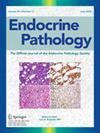表达 TPIT 和 SF1 的多线垂体神经内分泌肿瘤:六例肿瘤的临床病理学系列。
摘要
腺上皮激素分泌细胞肿瘤现在被归类为垂体神经内分泌肿瘤(PitNETs),根据细胞分化情况进行了亚分类。正常的腺上皮细胞有三个分化系,分别由转录因子 PIT1、TPIT 和 SF1 驱动,它们负责调节激素基因的表达;PIT1 驱动 GH、PRL 和 TSH 的表达,TPIT 是 POMC 表达所必需的,POMC 的表达可产生 ACTH,而 SF1 则是 FSH 和 LH 表达的转录因子。绝大多数 PitNET 遵循这三种血系分化途径,但也有极少数 PitNET 没有血系分化或表达一种以上血系的生物标志物。最近的世卫组织分类继续使用 "多激素 "这一术语来描述具有一个以上品系特征的肿瘤,但更好的术语是 "多品系",因为有些肿瘤可能表达不止一个品系特异性转录因子,而没有由这些因子驱动的激素。最近的数据表明,表达 PIT1 和 SF1 的肿瘤是最常见的多系 PitNET。在此,我们报告了罕见的表达 TPIT 和 SF1 的 PitNET。这 6 名患者(5 名女性,1 名男性;平均年龄 54.8 岁;年龄范围 35-84 岁)在我们的 PitNET 患者系列中占比不到 1%。大多数患者的肿瘤在临床上无症状,没有激素过量的证据,垂体功能减退的程度不一;其中两人患有库欣病。所有患者都有大肿瘤,肿瘤平均大小为 2.46 厘米(1.1-5.0 厘米不等)。在两名库欣病患者的非肿瘤性腺垂体中发现了克鲁克透明变。平均Ki67标记指数为2.91%(范围2.03-3.94%)。所有肿瘤的 PIT1 和 PIT1 系激素(GH、PRL 和 TSH)均为阴性。一个肿瘤的 TPIT 呈局灶性,其余肿瘤 50%以上的肿瘤细胞呈弥漫性反应。SF1 在 5 个肿瘤中呈局灶性表达,在 1 个肿瘤中呈弥漫性表达。3 个肿瘤至少有一种促性腺激素(FSH 或 LH)的不同表达。有两个肿瘤表达 GATA3。三个肿瘤中存在不同的 ER-α 表达。所有肿瘤中的 CAM5.2 均呈阳性。除两个导致库欣病的肿瘤外,其他肿瘤的 p27 表达均正常。我们的研究证实,表达TPIT和SF1的多线PitNET是存在的,但极为罕见;它们可以没有临床功能,也可以导致库欣病。无论 PitNET 的功能状态如何,都需要常规应用垂体转录因子来识别这些肿瘤。对于这些罕见的多线型PitNET,仍需要有关其分子相关性和临床意义的数据。Tumors of adenohypophysial hormone-secreting cells, now classified as pituitary neuroendocrine tumors (PitNETs), have been subclassified based on cell differentiation. Normal adenohypophysial cells have three lineages of differentiation driven by the transcription factors PIT1, TPIT, and SF1 which are responsible for the regulation of hormone gene expression; PIT1 drives expression of GH, PRL, and TSH, TPIT is required for POMC expression that gives rise to ACTH, and SF1 is the transcription factor responsible for FSH and LH expression. The vast majority of PitNETs follow these three lineage differentiation pathways but rare PitNETs show either no lineage differentiation or express biomarkers of more than one lineage. The recent WHO classification continued the terminology "plurihormonal" for tumors that have features of more than one lineage but a better term is "multilineage" since some tumors may express more than one lineage-specific transcription factor without the hormones that are driven by those factors. Recent data indicate that tumors with expression of PIT1 and SF1 are the most common multilineage PitNETs. Here we report the existence of rare PitNETs that express TPIT and SF1. The 6 patients (5 female, 1 male; mean age 54.8 years; range 35-84 years) represent less than 1% of patients in our series of PitNETs. Most patients had clinically silent tumors with no evidence of hormone excess and variable degrees of hypopituitarism; two had Cushing disease. All patients had macrotumors with a mean tumor size of 2.46 cm (range 1.1-5.0 cm). Crooke's hyaline change was identified in the nontumorous adenohypophysis of the two patients with Cushing disease. The mean Ki67 labeling index was 2.91% (range 2.03-3.94%). All tumors were negative for PIT1 and PIT1-lineage hormones (GH, PRL, and TSH). TPIT was focal in one tumor, and the remaining tumors had diffuse reactivity in more than 50% of tumor cells. SF1 expression was focal in 5 tumors and diffuse in one. Three tumors had variable expression of at least one gonadotropin (FSH or LH). GATA3 was expressed in two tumors. Variable ER-alpha expression was noted in three tumors. CAM5.2 was positive in all tumors. With the exception of two tumors causing Cushing disease, p27 expression was intact. Our study confirms that multilineage PitNETs expressing TPIT and SF1 occur but are extremely rare; they can be clinically non-functional or can cause Cushing disease. Irrespective of functional status of a PitNET, routine application of pituitary transcription factors is warranted to identify these tumors. Data on the molecular correlates and clinical significance are still needed for these rare multilineage PitNETs.

 求助内容:
求助内容: 应助结果提醒方式:
应助结果提醒方式:


